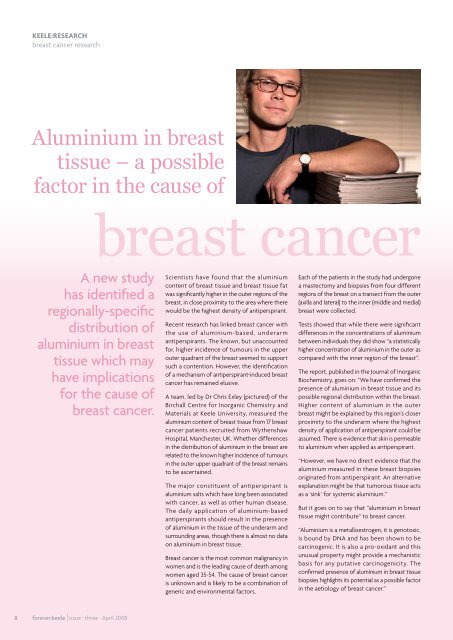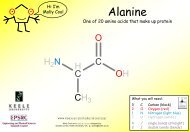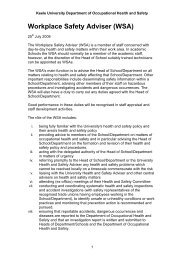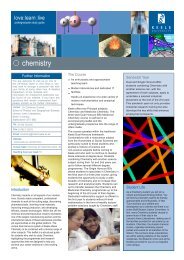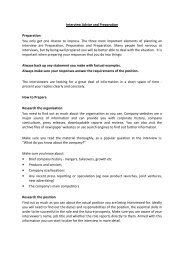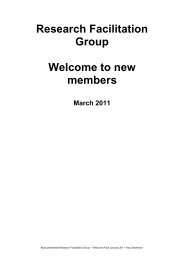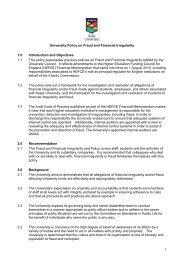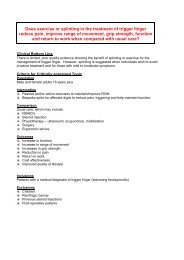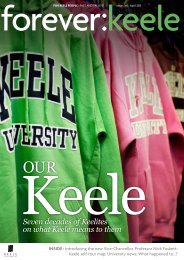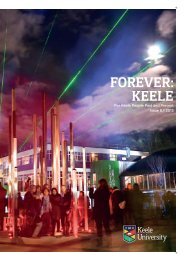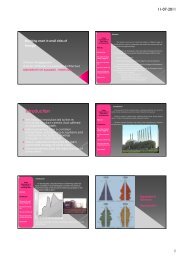Download - Keele University
Download - Keele University
Download - Keele University
You also want an ePaper? Increase the reach of your titles
YUMPU automatically turns print PDFs into web optimized ePapers that Google loves.
keele:research<br />
breast cancer research<br />
Aluminium in breast<br />
tissue – a possible<br />
factor in the cause of<br />
breast cancer<br />
A new study<br />
has identified a<br />
regionally-specific<br />
distribution of<br />
aluminium in breast<br />
tissue which may<br />
have implications<br />
for the cause of<br />
breast cancer.<br />
Scientists have found that the aluminium<br />
content of breast tissue and breast tissue fat<br />
was significantly higher in the outer regions of the<br />
breast, in close proximity to the area where there<br />
would be the highest density of antiperspirant.<br />
Recent research has linked breast cancer with<br />
the use of aluminium-based, underarm<br />
antiperspirants. The known, but unaccounted<br />
for, higher incidence of tumours in the upper<br />
outer quadrant of the breast seemed to support<br />
such a contention. However, the identification<br />
of a mechanism of antiperspirant-induced breast<br />
cancer has remained elusive.<br />
A team, led by Dr Chris Exley (pictured) of the<br />
Birchall Centre for Inorganic Chemistry and<br />
Materials at <strong>Keele</strong> <strong>University</strong>, measured the<br />
aluminium content of breast tissue from 17 breast<br />
cancer patients recruited from Wythenshaw<br />
Hospital, Manchester, UK. Whether differences<br />
in the distribution of aluminium in the breast are<br />
related to the known higher incidence of tumours<br />
in the outer upper quadrant of the breast remains<br />
to be ascertained.<br />
The major constituent of antiperspirant is<br />
aluminium salts which have long been associated<br />
with cancer, as well as other human disease.<br />
The daily application of aluminium-based<br />
antiperspirants should result in the presence<br />
of aluminium in the tissue of the underarm and<br />
surrounding areas, though there is almost no data<br />
on aluminium in breast tissue.<br />
Breast cancer is the most common malignancy in<br />
women and is the leading cause of death among<br />
women aged 35-54. The cause of breast cancer<br />
is unknown and is likely to be a combination of<br />
generic and environmental factors.<br />
Each of the patients in the study had undergone<br />
a mastectomy and biopsies from four different<br />
regions of the breast on a transect from the outer<br />
(axilla and lateral) to the inner (middle and medial)<br />
breast were collected.<br />
Tests showed that while there were significant<br />
differences in the concentrations of aluminium<br />
between individuals they did show “a statistically<br />
higher concentration of aluminium in the outer as<br />
compared with the inner region of the breast”.<br />
The report, published in the Journal of Inorganic<br />
Biochemistry, goes on: “We have confirmed the<br />
presence of aluminium in breast tissue and its<br />
possible regional distribution within the breast.<br />
Higher content of aluminium in the outer<br />
breast might be explained by this region’s closer<br />
proximity to the underarm where the highest<br />
density of application of antiperspirant could be<br />
assumed. There is evidence that skin is permeable<br />
to aluminium when applied as antiperspirant.<br />
“However, we have no direct evidence that the<br />
aluminium measured in these breast biopsies<br />
originated from antiperspirant. An alternative<br />
explanation might be that tumorous tissue acts<br />
as a ‘sink’ for systemic aluminium.”<br />
But it goes on to say that “aluminium in breast<br />
tissue might contribute” to breast cancer.<br />
“Aluminium is a metalloestrogen, it is genotoxic,<br />
is bound by DNA and has been shown to be<br />
carcinogenic. It is also a pro-oxidant and this<br />
unusual property might provide a mechanistic<br />
basis for any putative carcinogenicity. The<br />
confirmed presence of aluminium in breast tissue<br />
biopsies highlights its potential as a possible factor<br />
in the aetiology of breast cancer.”<br />
8<br />
forever:keele | issue : three : April 2008


